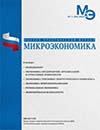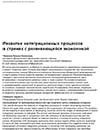Development of integration processes in countries with a emerging economy
The article discusses the features of integration processes in modern developing countries. Shows the goals that pursue nation-states in the organization of integration unions. The position of the majority of associations of developing countries within the stages of development of world integration processes is indicated. The current and forecast dynamics of economic indicators of developing countries in comparison with the indicators of developed countries and the world as a whole is analyzed. Based on relevant statistics, a number of existing integration unions of countries with developing economies from various regions of the world are examined in terms of their composition and basic socio-economic parameters. The negative trends in the development of modern integration processes in countries with developing economies are investigated and the reasons hindering the effectiveness of their integration are identified.
References:
|
1. Balassa B. The Theory of Economic Integration. Homewood, Illinois: Richard D. Irwin. 1961. 304 р. URL: https://archive.org/details/theoryofeconomic0000bala (In Eng.). 2. Balassa B. The Theory of Economic Integration: An Introduction. In: Nelsen B.F., Stubb A.CG. (eds). The European Union. Palgrave, London. 1994. pp. 125–137. DOI: https://doi.org/10.1007/978-1-349-23984-9_15 (In Eng.). 3. Maddison A. Growth and Interaction in the World Economy: The Roots of Modernity. Washington, D.C.: The AEI Press, 2005. 93 p. (In Eng.). 4. Maddison A. The World Economy. OECD, 2006. 667 p. URL: https://www.stat.berkeley.edu/~aldous/157/Papers/world_economy.pdf (accessed 05.08.2018) (In Eng.). 5. Chernikov G.P., Chernikova D.A. Very large transnational corporations and the modern world. Moscow: CJSC “Publishing House” Economics “, 2008. 399 р. (in Russ.). 6. Portanskiy A.P. Regionalism in the World and Integration in CIS // Russian Foreign Economic Journal. 2011. № 11. pр. 8–17 (in Russ.). 7. Poskrebysheva N.A. Economic integration within modern TNCs: investment aspect // Russian Foreign Economic Journal. 2011. № 10. P. 109–115 (in Russ.). 8. Bykov A.I. Economic cooperation within the SCO: main directions and prospects of development: monograph. Moscow: Flinta: Nauka, 2011. 232 p. (in Russ.). 9. Hausman R. The Party’s over // BRICS Business Magazine. 2013-2014. Russian Edition № 4. URL: https://bricsmagazine.com/ru/articles/vecherinka-zakonchena (accessed 05.08.2018) (in Russ.). 10. Gurova I.P., Efremova M.V. Competing Theories of Regional Economic Integration: A Comparative Analysis // Vlast’ = The Authority. 2013. № 8. pр. 35–38 (in Russ.). 11. Zuev V.N. Methodology of classification and assessment of forms of regional integration // Eurasian Economic Integration. 2014. №. 3 (24). pр. 25–43 (in Russ.). 12. Ushkalova D.I. Economic effects of regional integration: myths and reality // The Bulletin of the Institute of Economics of the Russian Academy of Sciences. 2017. № 4. pр. 120–137 (in Russ.). 13. Saliyeva N.Sh. The Role of External Factors in the Development of Integrational Processes in Developed and Developing Regions of World Economy // Bulletin of the Tajik State University of Law, Business and Politics. Social science series. 2019. № 1 (78). pр. 123–132 (in Russ.). 14. Vertakova Yu.V., Nekipelova A.S. Implementation of competitive advantages of the Eurasian Economic Union: foresight-designing // Proceedings of Southwest State University. 2017. Vol. 21. № 5(74). Рр. 123–130. DOI: 10.21869/2223-1560-2017-21-5-123-130 (in Russ.). 15. Netreba V.N. The main prospects and directions of development of international scientific and technical cooperation in modern conditions of globalization // Innovation and Investment. 2018. № 2. pр. 89–91 (in Russ.). 16. Sun Yu., Platonova E.D. Stages of the evolution of institutes of the integration on the economic space of the regional interstate associations (theoretical aspect) // Internet Journal «Naukovedenie». 2017. V. 9. № 4. P. 44 (in Russ.). 17. Yakovlev P.P. Integration in Latin America: centripetal and centrifugal trends // Outlines of global transformations: politics, economics, law. 2017. № 10(4). pр. 86–100. DOI: 10.23932/2542-0240-2017-10-4-86-100 (in Russ.). 18. Stefanova I.V. The theory of economic integration: the common development and specific features // Journal of Economy and entrepreneurship. 2017. № 9-3 (86). pр. 1218–1221 (in Russ.). 19. Molkova A.A. State Protectionism in the Global Economy // Vestnik of Astrakhan State Technical University. Series: Economics. 2017. № 4. pр. 15–21. DOI: 10.24143/2073-5537-2017-4-15-21 (in Russ.). 20. Kuzmina V.M. Features of international economic cooperation in the EAEU // Proceedings of the Southwest State University. Series: Economics, Sociology and Managment. 2018. Vol. 8. № 4 (29). pp. 17–26 (in Russ.). 21. Spartak A.N. Metamorphosis of regionalization: from regional trade agreements to megaregional projects // Outlines of global transformations: politics, economics, law. 2017. № 10 (4). pр. 13–37. DOI: 10.23932/2542-0240-2017-10-4-13-37 (in Russ.). 22. The International Monetary Fund (IMF) / World Economic Outlook Reports. URL: https://www.imf.org/en/Publications/WEO (accessed 05.08.2018). 23. The World Bank / Global Economic Prospects. URL: https://www.worldbank.org/en/publication/global-economic-prospects (accessed 05.08.2018).
|



